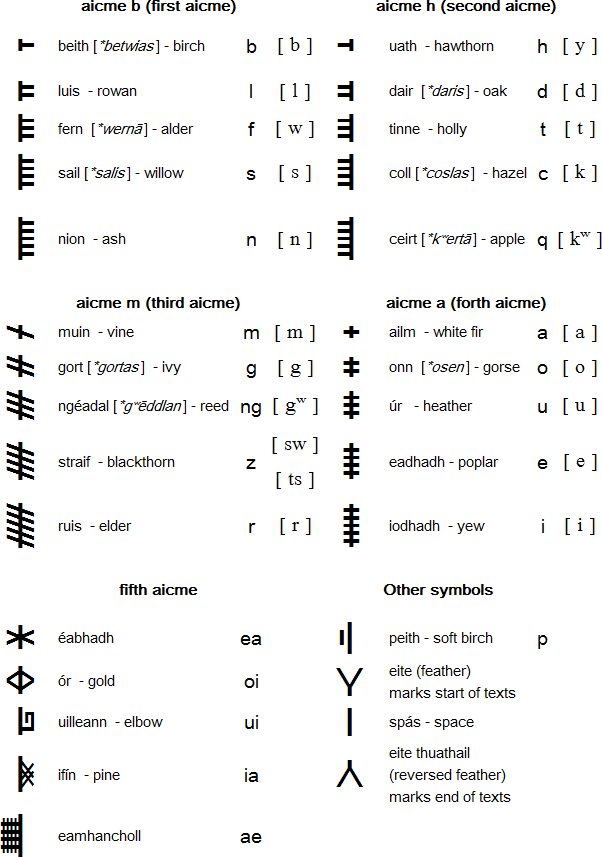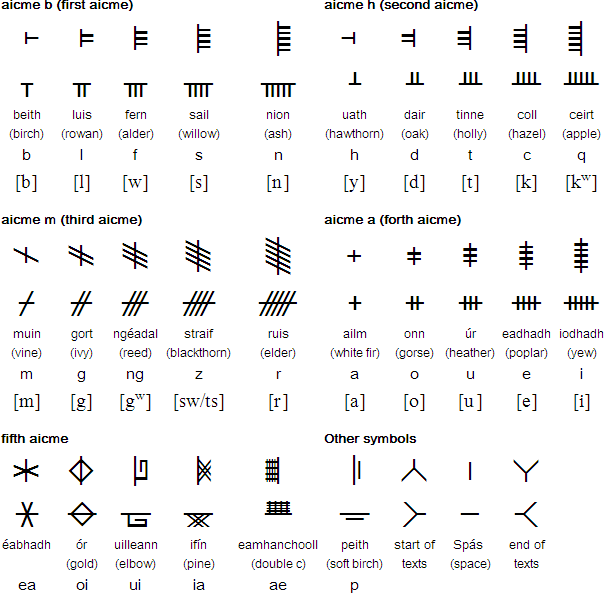(᚛ᚑᚌᚐᚋ᚜)
The Ogham alphabet is thought to be named after the Irish god Ogma. One theory of its origins is that it evolved out of a system of tallies used for accounting. Ogham is also known as or ogham craobh, beth luis fearn or beth luis nion.About 500 Ogham inscriptions have been found in Ireland, Scotland, Wales, England and the Isle of Man dating from between the 4th and 7th centuries AD. There are inscriptions in ancient Irish and Pictish which have not been deciphered. A number of bilingual inscriptions in Ogham and Latin or Ogham and Old Norse written with the Runic alphabet have been found.
While all surviving traces of Ogham are inscriptions on stone, it was probably more commonly inscribed on sticks, stakes and trees. Inscriptions generally take the form of somebody's name and the name of a place and were probably used to mark boundaries.
Notable features
- Type of writing system: alphabet
- Number of letters: 25, which are grouped into five aicmí (sing. aicme = group, class). Each aicme is named after its first letter. Originally Ogham consisted of 20 letters or four aicmí; the fifth acime, or Forfeda, was added for use in manuscripts.
- Writing surfaces: rocks, wood, manuscripts
- Direction of writing: inscribed around the edges of rocks running from bottom to top and left to right, or left to right and horizontally in manuscripts.
- Letters are linked together by a solid line.
- Used to write: Archaic Irish, Old Welsh and Latin
The Ogham alphabet (vertical)
The pronunciation of the letters shown is for Primitive / Archaic Irish the language used in the majority of Ogham inscriptions. The names and sounds represented by of the letters uath and straif are uncertain. There are many different version of the letter names - the standard ones are used here [with the Primitive Irish ones, where known, in bracketts] - others can be found at: evertype.com.
The Ogham alphabet (horizontal)

Downloads
Download a Ogham alphabet chart in Excel, Word or PDF formatSample texts in Ogham
Texts in Primitive Irish
Transliteration
LIE LUGNAEDON MACCI MENUEHTranslation
The stone of Lugnaedon son of LimenuehFrom: Inchagoill Island, County Galway, Ireland
An Old Irish Joke in Primtive Irish (translation by David Stifter)

Transliteration
Tengwās īwerijonākāTut raddassodd trīs dītrebākī dīslondetun do bitū.
Tēgoddit in wāssākan do atareregiyī esyan kenutan writ dēwan.
Bāddar kina labarātun writ alaliyan qos qennan blēdaniyās.
Issit andan esset bīrt wiras dī ēbis writ alaliyan diyas blēdniyas: “mati ad tāyomas.”
Bowet samali qos qennan blēdaniyās.
“Issit mati sodesin,” esset bīrt aliyas uiras.
Bāddar andan ēran sodesū qos qennan blēdaniyās.
“Tongū wo mō brattan,” esset bīrt trissas uiras, “ma nīt lēggītar kiyunessus do mū, imbit gabiyū wāssākan oliyan dū swi.”
Old Irish (Sengoídelc) version
Tríar manach do·rat díultad dont ṡaegul.Tíagait i fásach do aithrigi a peccad fri día.
Bátar cen labrad fri araile co cenn blíadnae.
Is and as·bert fer diib fri araile dia blíadnae, “Maith at·taam,” olse.
Amein co cenn blíadnae.
“Is maith ón,” ol in indara fer.
Bátar and íar suidiu co cenn blíadnae.
“Toingim fom aibit,” ol in tres fer, “mani·léicthe ciúnas dom co n-imgéb in fásach uile dúib.”
Modern Irish (Gaeilge) version (by Dennis King)
Triúr manach a thug diúltú don saol.Téann siad ins an fhásach chun aithrí a dhéanamh ina gcuid peacaí roimh Dhia.
Bhí siad gan labhairt lena chéile go ceann bliana.
Ansin dúirt fear díobh le fear eile bliain amháin ina dhiaidh sin, “Táimid go maith,” ar seisean.
Mar sin go ceann bliana.
“Is maith go deimhin,” arsa an dara fear.
Bhí siad ann ina dhiaidh sin go ceann bliana.
“Dar m’aibíd,” arsa an treas fear, “mura ligeann sibh ciúnas dom fágfaidh mé an fásach uile daoibh!”
English version (by Dennis King)
Three holy men turned their back on the world.They went into the wilderness to atone for their sins before God.
They did not speak to one another for a year.
At the end of the year, one of them spoke up and said, "We’re doing well."
Another year went by the same way.
"Yes we are," said the next man.
And so another year went by.
"I swear by my smock," said the third man, "if you two won’t be still I’m going to leave you here in the wilderness!
Source: http://www.smo.uhi.ac.uk/sengoidelc/donncha/tm/ilteangach/
Texts in Latin
Transliteration
Numus honoratur sine. Numo nullus amatur.Translation
Money is honoured, without money nobody is lovedFrom: The Annals of Inisfallen of 1193

From: The Book of Ballymote (Leabhar Bhaile an Mhóta), written in 1390 or 1391.
Links
Information about Oghamhttp://www.evertype.com/standards/og/ogmharc.html
Free Ogham fonts
http://www.evertype.com/celtscript/ogfont.html
http://www.csupomona.edu/~jcclark/ogham/
Photos of Ogham stones with transliterations of the inscriptions
http://titus.uni-frankfurt.de/ogam/ogsing.htm
Examples of Ogham inscriptions
http://en.wikipedia.org/wiki/Ogham_inscription
Details of the Book of Ballymote
http://en.wikipedia.org/wiki/Book_of_Ballymote
http://www.ria.ie/library/special-collections/manuscripts/book-of-ballymote.aspx
http://www.maryjones.us/ctexts/bb.html
http://staffweb.itsligo.ie/staff/jforan/Irish_project/Alt14/alt14a.htm
Translating Ancient Ogham - an introduction to linguistic archaeology in Ireland
http://www.celticgrounds.com/chapters/ogham_translat.htm
No comments:
Post a Comment
Note: Only a member of this blog may post a comment.